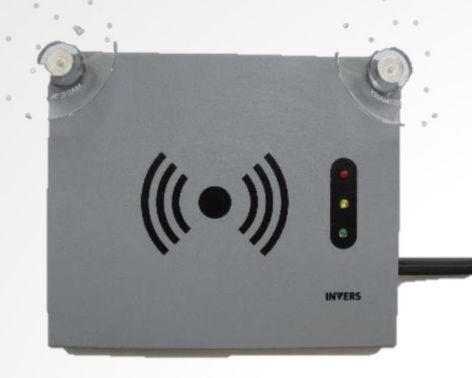Use of RFID cards
Feature description
The TMF platform supports the use of RFID cards to (un)lock the vehicle so a shared vehicle can be used without the need of a smartphone during the trip. Commonly this feature is used for car sharing amongst a closed group, for example employees of a company. The use of RFID cards can be mixed with the use of the TMF app. An example: during office hours the vehicle is used by a company where the employees use a RFID cards to get access to the car while outside office hours the car is shared with the neighbourhood through the smartphone app.
The RFID card is solely used to open and close the car. A reservation still has to be made through the smartphone app or the webapp to determine who has access to the vehicle at which time.
Hardware
In order to use RFID cards the Invers multi card reader has to be installed in the vehicle and connected to the cloudboxx. The card reader is placed behind the windshield of the car.

The RFID card reader reads the Hitag Format and the ISO 14443 Formate (Mifare). Find below a detailed list of supported card formats:
- hitag_1
- iso14443a_mifare
- legic
- iso14443a_4
- iso14443b_4
- felica
- iso15693
- hid_prox // does not have uid
- hid_iclass
- awid
- indala
- iso14443b_prime
- em_410x // only supported with card reader firmware > 1.71
Setup in Control Center
A RFID card has to be linked to a certain person on the platform. This can be done in Control Center. A RFID card is a personal key to use the shared vehicles. A RFID card can be linked by going to the person in Control Center and clicking on the tab rfid cards.
Adding a RFID card takes two parameters. The UID (unique ID) of the card and a description. The description is a free text field that can be used to your organisations' liking. For example, if you label the RFID cards with a certain number, you can enter this label number here.
The UID of the card has to be entered in a specific format. The full, raw, UID of a RFID card is a long hexadecimal string. Only the first 4 bytes should be entered. Every character in the hexadecimal is one octet (8 bits). To get the first 4 bytes we need the first 8 characters of the hexadecimal UID. Because the hexadecimal is a representation of a binary number it needs to be added from right to left per byte (16 bits or 2 octets) this step is only necessary if your reader and it's accompying software does not do this step for you. In doubt a test in conjuction with TMF support can be performed.
Example
- Full raw hexadecimal UID is: 96A479F1BA0804000207D97B4485FF1D
- first 4 bytes (8 octets) are 96A479F1
- Read from right to left per byte becomes: F179A496
F179A496 is the number that should be added. Control Center will automatically append zero's to the entered 4 bytes until the full length is 16 characters.
Permission
A control center admin needs the persons:edit permission to manage rfid cards.
How to use the RFID card
- badging the card once will open (or close) the vehicle. If the reservation has not been started yet the reservation will be started. The LEDs of the reader start bliking for 20 seconds.
- badging the card a second time within 20 seconds (while the LEDs are blinking) will end the reservation and finish the usage
Common helpdesk scenarios
Accidently ending reservation
If the user accidently badges twice within 20 seconds the reservation is started and immediatly ended again. The user won't have access to the vehicle anymore because there is no pending reservation anymore. The user should only badge twice or wait until the LEDs stopped blinking. The helpdesk should instruct the user to create a new reservation with the smartphone app (if present) or create a reservation for the user in Control Center (currently creating reservations in control center is not yet available)